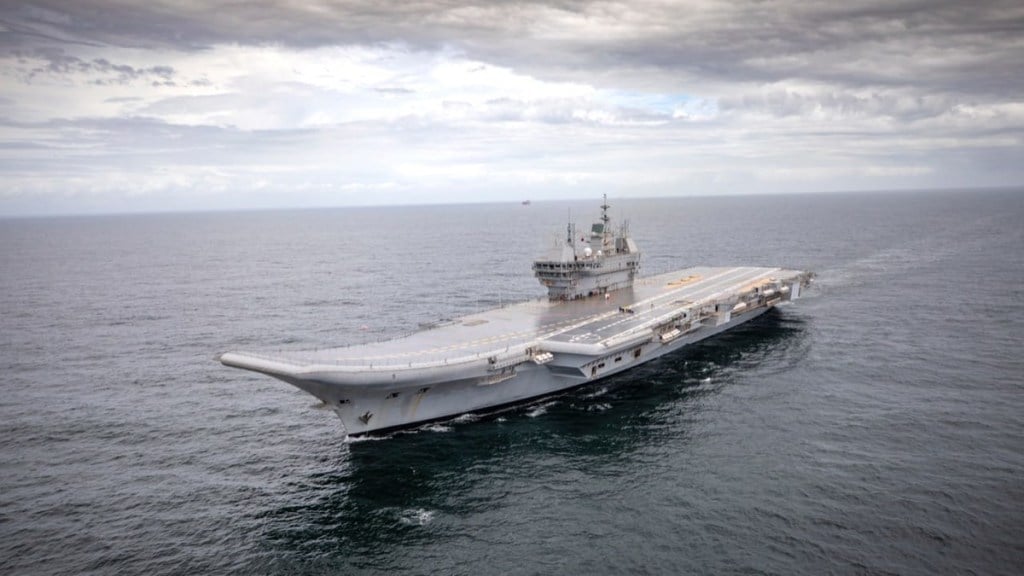India’s first Indigenous Aircraft Carrier (IAC) `Vikrant’ is a prime example of an impressive engineering feat. With the induction of suitable fighter aircraft, India’s first IAC will be able to project power along the country’s maritime boundaries from long range.
The Indian Navy has been focusing on boosting its overall capabilities in light of China’s increasing attempts to bolster its military presence in the Indian Ocean region (IOR). The IOR is critical to the strategic interests of New Delhi. Once the new `Vikrant’ is commissioned into service, India will possess two carriers. This would allow the nation to always have at least one of these warships out in the waters while the other is undergoing maintenance or upgrades. `Vikrant’ would strengthen India’s position in the IOR and aid in its quest to become a blue water navy.
India is planning to have three carriers. It is already constructing the next indigenous carrier, IAC Vishal. This carrier will be bigger than the present two and is likely to have a displacement of 65,000 tons.
`Vikrant’ is an excellent first, likely to become a remarkable precedent in India’s journey to becoming self-reliant in defence designing and manufacturing.
More about IAC-Vikrant
It is 262 metres (860 feet) long, 62 metres (203 feet) wide aircraft carrier that displaces about 45,000 metric tonnes. Its dimensions are comparable to those of the Indian Navy’s current aircraft carrier- INS Vikramaditya, a fully upgraded Kiev-class warship.
Vikrant is powered by four General Electric LM2500 marine gas turbines on two shafts, generating over 80 megawatts (110,000 Horsepower) of power. It has a speed of 51 kilometres per hour (32 miles per hour) and endurance of around 13,890 kilometres (8630 miles). The total cost of the project is about 20,000 crore. And after getting commissioned next week on September 2, 2022, the aircraft carrier is expected to become fully operational by the end of 2023.
Radar System
Vikrant is equipped with the MF-Star radar supplied by Israel; it is capable of surface search and tracking aerial assets. This multifunction active electronically scanned array (AESA) radar has been developed by the Elta division of Israel Aerospace Industries (IAI). The radar system consists of 4 active arrays operating in the S-Band (frequencies from 2 to 4 gigahertz on the electromagnetic spectrum). Each one of these arrays is placed facing a cardinal direction. It can track hundreds of targets simultaneously. It is also understood that the system is capable of guiding 24 missiles. The radar system can also detect large aerial targets at distances of over 300 kilometres (185 miles) and sea-skimming cruise missiles at ranges greater than 25 kilometres (15.5 miles). The actual values, which are classified, are thought to be much higher.
Experts believe that the MF-Star is on equal footing with the US Navy’s Aegis combat system that uses the AN/Spy-1D radar. Aegis comprises the core of the US’ sophisticated Arleigh Burke-class destroyers and Ticonderoga-class cruisers.
Air Wing
IAC Vikrant features a Short Take-Off But Arrested Recovery (STOBAR) configuration with a ski jump.
What does this mean?
Under this design, the pilot raises the thrust of the aircraft by turning on the afterburners while retaining the plane by braking. Following this, two panels are raised from the carrier’s deck in front of the aircraft’s main landing gear. This ensures that the plane remains stationary. The pilot releases the brake on command; the panels from the deck also fall back into their place. The aircraft rapidly moves ahead under maximum thrust. The plane is launched up and ahead due to rolling over the ski ramp.
India is yet to finalise which fighter jet will serve on the carrier and the final decision is awaited on Dassault Aviation’s Rafale M (Marine) and Boeing’s F/A-18 Super Hornet.
Read More: Race begins! F/A-18 Super Hornet next-generation Block III capability will be game changing for India: Boeing
Financial Express Online reported in December 2020, Boeing demonstrated its aircraft’s operations from Indian carriers at Naval Air Station Patuxent River in Maryland, a shore-based test facility in the US. The features of the Super Hornet and the prospect of gaining technical and operational know-how from the USN make it an attractive offering. At the same time, the prepared infrastructure and cost-effectiveness of operating the Rafale-M (due to the Indian Air Force already using it) make Dassault’s offering a strong contender, too. Which aircraft will make the cut remains to be seen.
Presently, the Russian MiG-29K is the Indian Navy’s standard carrier fighter. It operates from INS Vikramaditya. Vikrant will also have a mix of Kamov KA-31 Helix airborne early warning helicopters, KA-28 Helix anti-submarine helicopters, and HAL Chetak plane-guard and utility helicopters serving onboard. Depending on the jet India picks, the carrier will be able to accommodate 20-26 aircraft.
Defensive Weapons
The primary air defence of INS Vikrant is the Barak 8 missile defence system, which has been jointly developed by India and Israel. This system, which has a range of 90 kilometres (56 miles), is intended to intercept supersonic cruise missiles that move a few metres above the water.
One of the notable features of Barak 8 is its minimum engagement range, which is known to be only 500 metres (0.31 miles). This implies that the system is equipped to target an incoming hostile object up until the last couple of seconds. This would provide the end user with the ability to target the incoming hostile object multiple times. It would also enable the forces to intercept missiles that are significantly close to the ship. The system can perform the role of point-defence Surface-to-Air missiles (SAM) as well. The carrier is expected to have two 32 vertical launch system cells.
The role of the Close-in weapon system (CIWS) is up to the four AK-630 Gatling guns (the last three digits referring to the six gun barrels and their 30 mm calibre). Firing these would be a last-ditch defence against missiles.


